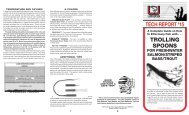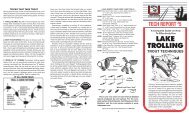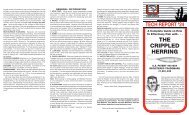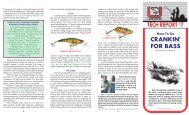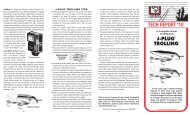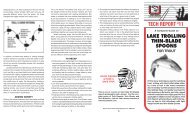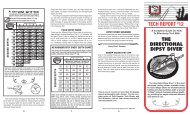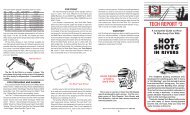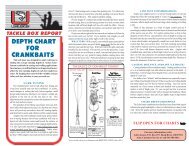Create successful ePaper yourself
Turn your PDF publications into a flip-book with our unique Google optimized e-Paper software.
aitfish (stunned, struggling or dying) engineered into<br />
it. Available in 17 sizes from 1/6-oz. to a whopping 20-<br />
oz. model perfect for deep or heavy current conditions.<br />
See Luhr-Jensen Tech Sheet #548 for a<br />
complete guide on how to most effectively fish with<br />
this lure.<br />
Cast Champ ®<br />
CAST CHAMP ® -- Long a favorite casting wobbler,<br />
this is an excellent jigging spoon, having an erratic,<br />
fluttering action when allowed to free-fall. It comes in<br />
nine sizes from 1/10-oz. to 3-oz. and is available in 11<br />
finish variations on Brass, Chrome and even Genuine<br />
24K Gold Plate. Prism-Lite ® accents are available on<br />
many models.<br />
temperature level, as it relates to different species,<br />
and the thermocline. With the onset of warm spring<br />
weather, lakes stratify into three distinct layers and<br />
remain that way until fall. The middle layer of water,<br />
where there is a large concentration of dissolved<br />
oxygen, baitfish and therefore predator fish is called<br />
the thermocline and can generally be found from 10<br />
to 80 feet down. This not only is an oxygen-rich layer<br />
but also a temperature layer as well and fish relate to<br />
it, both as a comfort zone and an area where their<br />
body metabolism functions efficiently.<br />
The peak feeding and optimum temperature for<br />
coho and chinook salmon is 55 0 with an active<br />
range from 44 0 to 58 0 . For lake trout, peak feeding<br />
and optimum temperature is 50 0 with activity<br />
from 43 0 to 53 0 . For steelhead, optimum temperature<br />
is between 50 0 and 55 0 with activity from 40 0<br />
to 75 0 . Brown and rainbow trout have an optimum<br />
temperature preference between 55 0 and 60 0 with<br />
activity from 44 0 to 75 0 . Striped bass exhibit a<br />
range of temperature preference from 60 0 to 78 0<br />
with the optimum temperature between 70 0 and<br />
72 0 .<br />
Fish rarely venture out of these preferred temperature<br />
zones, except to catch a meal, and then will<br />
return quickly. One thing to remember when fishing<br />
temperature layers such as the thermocline is that<br />
they can change from day to day because of wind<br />
and/or wave action and you'll have to relocate them<br />
each time out.<br />
have to battle currents. You'll have about three hours<br />
of prime fishing time around each tide change and it's<br />
extremely important to fish these periods intensely.<br />
Purchase a tide book for your area and become<br />
familiar with it and schedule your trips, if possible, to<br />
coincide with the change periods.<br />
If the tides are moving fast, salt water species such<br />
as salmon, which are ordinarily open-water feeders,<br />
will seek shelter around structure such as points of<br />
land, underwater islands and other areas where they<br />
won't have to battle current. These will be the places<br />
to seek them out with your jigging lures. Bottomfish,<br />
on the other hand aren't influenced by the tides and<br />
always are close to rocks, pinnacles and dropoffs so<br />
your search for these should be concentrated near<br />
structure.<br />
SHARP HOOKS PAY OFF<br />
One of the easiest things you can do to improve<br />
your fishing success is to maintain super-sharp hooks<br />
on your lures at all times. A fine-toothed file such as<br />
Luhr Jensen's Sharp Hook File is the absolute best<br />
hook sharpening tool available. Hold the file parallel<br />
to the point and with gentle, one-way strokes, remove<br />
a small amount of metal on at least two sides to obtain<br />
a sticky-sharp point with a knife-like cutting edge.<br />
TECH REPORT # 21<br />
A Complete Guide to<br />
OPEN WATER<br />
DRIFT<br />
JIGGING<br />
TECHNIQUES<br />
(Revised)<br />
PROSPECTING OPEN WATER<br />
Fresh and salt water gamefish all relate, in one form<br />
or another, to either structure (bottom contours) currents<br />
or temperature zones. Here are some tips to<br />
make your search pay off in the shortest amont of time<br />
when coupled with the use of a quality depth sounder.<br />
TEMPERATURE / OXYGEN (Fresh <strong>Water</strong>) -- In<br />
large fresh water lakes and reservoirs, the critical<br />
factor in finding fish is the location of the preferred<br />
6<br />
TIDE/CURRENTS (Salt <strong>Water</strong>) -- Just as knowledge<br />
of temperature layers is critical for fresh water<br />
fishing, a knowledge of tides and currents is essential<br />
for salt water drift jigging success. Feeding activity of<br />
salmon and other salt water gamefish is at its maximum<br />
during the period from one hour before, through<br />
and one hour after a tide change. A tide cycle has two<br />
highs and two lows so there are at least two daylight<br />
tide change periods to fish each day which provide<br />
optimum conditions. Charting one tide period, we<br />
would have low slack (the time of change), ebb (run<br />
out) and back to low slack. If the tide fluctuation is<br />
minimal between high and low, say 3 to 8 feet, fish will<br />
be active throughout the tide cycle along rips, in<br />
eddies and many times in open water. But the period<br />
before slack tide, during the slack and just after will<br />
still provide you with top angling as salmon and<br />
bottomfish will feed most actively when they don't<br />
7<br />
Hook File<br />
w/Lanyard<br />
& Snap<br />
Hook File<br />
with Handle<br />
This is one of a series of more than 25 detailed<br />
technique reports produced by Luhr Jensen &<br />
Sons. For a complete set, a patch for your jacket<br />
or cap, a price list and a full-color catalog featuring<br />
all of our quality fishing lures and accessories,<br />
send $3 (credited to your first order of $20 or<br />
more) along with your name and address to: Luhr<br />
Jensen, P.O. Box 297, Hood River, OR 97031.<br />
Attn: Customer Service.<br />
Visit us on the web at www.luhrjensen.com #8822-021 Revised 051603 Litho in U.S.A.<br />
8<br />
Sharp<br />
Hook File<br />
<strong>Drift</strong> jigging in open water is a fishing<br />
technique being used by an ever increasing<br />
number of anglers as they discover its<br />
effectiveness and ease of application.<br />
It's a technique tailor-made for open water,<br />
fresh or salt, where fish are oriented<br />
either to bottom structure or temperature<br />
layers. With the aid of a depth<br />
sounder, drift jigging allows pinpoint presentation<br />
of a spoon or jig within inches<br />
of a fish, providing you with a distinct<br />
advantage not easily obtainable with other<br />
fishing methods.<br />
© Luhr Jensen & Sons, Inc.
A<br />
B<br />
DRIFT JIGGING<br />
TECHNIQUE<br />
Free-spool jig or spoon to bottom or<br />
desired level. Raise rod tip 6" to 4' to<br />
begin motion.<br />
Drop rod tip sharply causing slack to<br />
develop which allows the lure to flutter<br />
back to starting level. Pause 2 seconds<br />
after line tightens up and then begin<br />
another upward stroke.<br />
By using wind or current to change your boat<br />
position, in open water drift jigging you will be<br />
prospecting different areas until a concentration<br />
of fish is located. Then, either by using a motor or<br />
oars to hold your position, or by motoring back<br />
and repeating the drift, you will be able to stay<br />
over them.<br />
Once fish are located, free-spool the jig or spoon to<br />
the desired depth and then begin a series of varied<br />
jigging motions which impart erratic actions to the<br />
lure.<br />
The jigging technique consists of raising your rod<br />
anywhere from six inches to four feet, throwing some<br />
slack in the line as the rod tip is lowered toward the<br />
water, pausing and then raising the rod upward again.<br />
A two second pause is recommended after the lure<br />
has been allowed to fall. It's best to vary the distance<br />
of the upward rod motion with each sweep so the<br />
spoon or jig produces the most erratic and varied<br />
actions possible.<br />
Strikes which come when working a jig or<br />
jigging spoon almost always occur as the lure is<br />
falling. Hesitation in the descent of a lure, a twitch<br />
of the line, a "tap" or any other unusual motion or<br />
happening as the lure is falling should be immedi-<br />
B<br />
A<br />
ate reason for setting the hook. Many times you<br />
will not be able to detect the "strike" but will feel<br />
resistance as you begin to raise the rod. This too<br />
signals "set the hook".<br />
An aid in detecting strikes when a lure is falling is<br />
the use of a premium-quality high-visibility line such<br />
as Trilene XT ® , which also has high knot strength and<br />
thin diameter in relation to pound test. By carefully<br />
watching the line as the jig or spoon is falling, you will<br />
be able to detect slight twitches in the line as the strike<br />
occurs.<br />
If you haven't developed any strikes in a particular<br />
column of water, change the location of your boat<br />
slightly, either by drifting or motoring so you will<br />
constantly be covering new water. It is important to<br />
keep moving until fish are located.<br />
DEPTH SOUNDERS<br />
There is no substitute for a good quality depth<br />
sounder, such as those made by Bottomline ® . In drift<br />
jigging open water where fish can be just about<br />
anywhere . . . it will take the guesswork out of<br />
otherwise countless hours of blindly prospecting for<br />
them. A fish finder unit will pinpoint the depth at which<br />
fish are suspended and, to the knowledgeable eye,<br />
reveal structure and fish close to structure. A fish<br />
finder unit also will enable you to spot underwater<br />
contour changes such as ledges, dropoffs and islands<br />
that otherwise can't be located or fished over<br />
with any degree of consistency.<br />
The beauty of a depth sounder in drift jigging lies in<br />
its ability to tell you exactly at what depth the fish are,<br />
how many of them there are, whether they are near<br />
structure on the bottom or suspended and, above all,<br />
it allows you to move with them once they're found<br />
and keep your lures within inches of them.<br />
JIGGING LURES<br />
Lures used for drift jigging can take on several<br />
forms, the most popular being jigging spoons such as<br />
the Krocodile ® and Cast Champ ® and fish-shaped<br />
lead jigs such as the Crippled Herring ® and the<br />
Deep Stinger . Regardless of whether you're fishing<br />
salt or fresh water, you should try to match the size of<br />
the jig or jigging spoon as closely as you can to the<br />
prevalent baitfish in the area as well as to your tackle.<br />
If using lightweight lures, you'll need lighter tackle --<br />
heavier tackle for jigs and spoons from three to seven<br />
ounces.<br />
The desired depth also has a great deal to do with<br />
your selection of a spoon or jig. For example, you will<br />
need a heavier lure for fishing in 100 feet of water than<br />
needed for fishing 20-foot depths.<br />
It is advisable to carry several sizes of Krocodiles,<br />
Crippled Herring, and Deep Stingers so you can<br />
match any water and depth condition.<br />
THE IMPORTANCE OF COLOR<br />
A wide variety of painted finishes and color combinations<br />
are available on Luhr Jensen jigging spoons<br />
and jigs. Color becomes very important related to the<br />
depth you'll be fishing, with colors changing depending<br />
upon how deep they go. Red filters out of the color<br />
spectrum first at about 30 feet and yellow and chartreuse<br />
at about 60 feet with blues, greens and darker<br />
colors the last ones to turn gray. White and/or pearl<br />
turn gray at about 60 feet and black is always black,<br />
regardless of depth. This means a fish in deep water<br />
will see blacks, grays, blues and greens in terms of<br />
day-to-day food while a shallow water fish would be<br />
tuned in to all colors.<br />
The special glo finishes produced by Luhr Jensen<br />
are designed specifically for deep water jigging. They<br />
contain phosphor pigments that absorb light on the<br />
surface and then give it off down deep. Note:<br />
Phosphorescent finishes contain light-sensitive<br />
pigments which can be burned and turn gray if<br />
exposed to strong, direct sunlight for more than<br />
15 minutes.<br />
DEEP STINGER - This solid lead body, minnowshaped<br />
jig is available in sizes 3/4-oz., 1-oz., 2-oz. 4<br />
1/2-oz, 6-oz. & 10 oz. It is a low drag, jigging and<br />
casting spoon which can be bent to enhance its<br />
action. It features heavy duty, welded ring constructon.<br />
When vertical jigging, the all-purpose bend<br />
should be retained. It produces a fluttering,<br />
rotating motion on slack line. An S-bend or C-<br />
bend (half-moon) will yield an erratic, fluttering<br />
action when trolling or casting.<br />
Krocodile ®<br />
KROCODILE ® -- Versatility best describes this lure<br />
which has the reputation for catching all kinds of fish<br />
in all kinds of conditions. It can be cast or trolled, and<br />
the thicker models make excellent jigging spoons as<br />
many bass anglers will attest. The "Kroc" comes in<br />
a wide variety of finishes to suit every fishing situation<br />
and weighs from 1/6-oz. to 7 ozs. for heavy-tackle,<br />
deep-water fishing.<br />
Crippled Herring ®<br />
2 3<br />
4 5<br />
Deep Stinger <br />
CRIPPLED HERRING ® -- This is the hottest jigging<br />
lure out today. It is natural both in appearance and<br />
action and can be used worldwide, every day of the<br />
year, for all baitfish-eating gamefish, in fresh and salt<br />
water. It is programmed to take advantage of the<br />
strong, natural predator instinct common to all game<br />
fish, with every movement of any type of distressed



